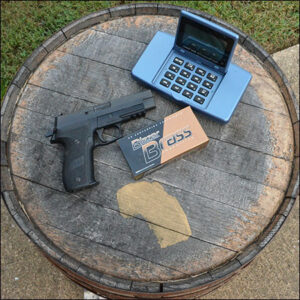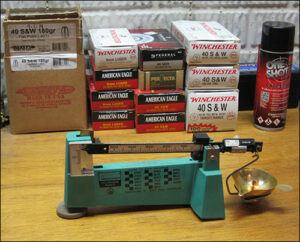If you’ve been around handgun shooting, or read any of the popular shooting magazines, you’ve probably heard the words “Power Factor.” You may have wondered what it is, how it’s measured, and if it’s really so important that you need to learn more about it.
If you are a competitive handgun shooter competing in USPSA, IDPA, or ICORE matches, you probably know all about it. Quite simply, it’s a measure of the power of the ammunition you are shooting. It can be measured, whether you are shooting factory ammo, or loading your own ammo at home. All you need is a scale to weigh your bullet, and a chronograph to measure the speed of the bullet as it travels downrange.
What is Power Factor?
Power Factor Equation: Bullet Weight x Bullet Speed

Power factor is measured as a number, like 125 or 165. It’s simply the weight of the bullet in grains, multiplied by the speed of the bullet in feet per second.
Example: A .45 ACP round with a 200 grain SWC bullet might travel downrange at 850 fps. The Power Factor of that load would be 200 X 850 = 170,000. The last three numbers are dropped for simplicity, and the power factor is 170.
Another example: A 9mm round with a 124 grain bullet traveling 1,150 feet per second. The power factor would be 124 X 1,150 = 142,600, or a power factor of 142.
Power Factor Explained – Why We Use It
The basic reason that we want to be able to measure power factor all comes down to one word – RECOIL!
Recoil is how much the gun “kicks” when you pull the trigger. While differences like gun design or weight of the gun can affect how much it kicks, a simple rule of thumb is that the higher number of power factor you have, the more your load will kick when fired. This is especially important in action pistol competition, where second and third follow-up shots take longer if you have more recoil to control. That’s why, to even the playing field, most competitors are always competing against others with similar types of guns, and similar power levels of ammunition.
While this power factor number is usually discussed in regard to competitive shooting, it can have some applications in self-defense ammo loading also. A higher power factor of ammo might be more effective in a self-defense situation than a lower power factor. However, other factors come into play, like bullet design (JHP vs. FMJ) and the actual diameter of the bullet as it enters the target.
If power factor is relevant to you, there’s a good chance that you are a competitive handgun shooter competing in USPSA, IDPA, or ICORE matches. These three organizations each have many thousands of US members, and each organization holds shooting tournaments at local area gun clubs virtually every week of the year. If you want to move beyond simple plinking and target shooting, contacting one of these groups is a great place to start! Below, we will discuss each of the organizations, what types of weapons are used in them, and what power factors are needed in the various classes within each organization.
IDPA Power Factor
The International Defensive Pistol Association uses a minimum required power factor for its divisions.
- Stock Service Pistol (SSP) – PF – 125. Mostly stock semi-autos with minimal changes, in caliber 9MM or larger.
- Enhanced Service Pistol (ESP) – PF – 125. Semi-autos in caliber 9MM or larger, with certain allowed modifications.
- Custom Defensive Pistol (CDP) – PF – 165. Semi-autos in caliber .45 ACP with certain allowed modifications.
- Compact Carry Pistol (CCP) – PF – 125. Semi-autos in caliber 9MM or larger, with certain allowed modifications. Barrel length must be 4.1” or less.
- Stock Revolver – PF – 105. Mostly stock revolvers in caliber .38 Special or larger. Barrel length must be 4.25” or less.
- Enhanced Revolver – PF – 155. Revolvers in caliber .357 Magnum or larger, with certain allowed modifications. Barrel length must be 4.25” or less.
Two other optional divisions are sometimes used at IDPA tournaments. They are Back-Up Gun (BUG) and are broken down to revolver or semi-auto. They have a power factor of 95. See the current IDPA Rule Book or website for more information.
USPSA Power Factor 
Most United States Practical Shooting Association Divisions have both a Major and Minor Power Factor. Hits outside of the “A” zone are worth more with major loads, and lower with minor loads. Check out the six USPSA divisions and their power factors below (power factor doesn’t matter for pistol caliber carbine shooters):
- Open Division – Major – 165, Minor – 125. Mostly highly modified semi-autos, with extended ported barrels and optic sights. Popular calibers are 38 Super Comp and 9MM Major.
- Limited Division – Major – 165, Minor – 125. Slightly modified semi-autos, with standard length barrels and iron sights. Caliber .40 S&W is the dominant load.
- Limited 10 Division – Major – 165, Minor – 125. Same general rules as Limited Division, but magazine capacity of 10 rounds maximum.
- Production Division – All loaded to Minor – 125. Basically stock semi-autos, with a few minor improvements. 9MM is the dominant caliber.
- Single Stack Division – Major – 165, Minor – 125. Semi-autos with minimal improvements. Popular calibers are .45 ACP and .40 S&W.
- Revolver Division – Major – 165, Minor – 125. Popular revolvers with specified improvements, in caliber .38 Special or larger.
International Confederation Of Revolver Enthusiasts – ICORE Power Factor
Open Division – PF – 120. Check current rule book for allowed changes
Limited Division – PF – 120. “ “ “ “ “ “ “
Limited 6 Division – PF – 120. “ “ “ “ “ “ “
Classic Division – PF – 120. “ “ “ “ “ “ “
Look carefully at the above organizations’ websites, and talk to some of your shooting buddies. You can’t go wrong joining any of these, and broadening your skills and enjoyment of your shooting hobby. Grab your husband or wife, boyfriend or girlfriend, and head out to the range soon! Be safe and have fun!
Shoot straight and shoot fast! Dave Z.












